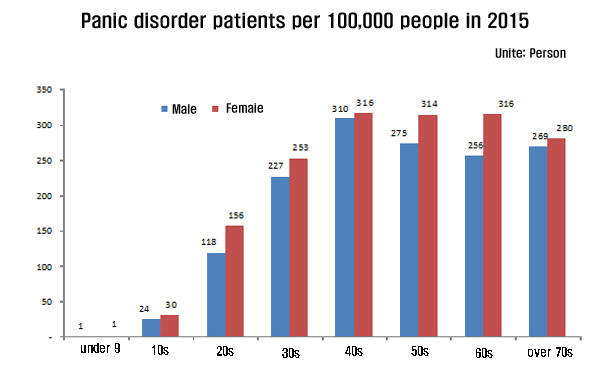Medical costs rise 13 percent on annual average
The number of Koreans suffering from “panic disorder” – an anxiety disorder characterized by recurrent and unexpected panic attack accompanying intense fear, palpitations, and shortness of breath – is increasing rapidly. Notably, the number of senior patients in their 70s or older surged 3.4 times in five years.
According to the analysis of health insurance big data conducted by the National Health Insurance Service (NHIS), the number of patients treated for the disease stood at 106,140 in 2015, recording an annual growth of 15.8 percent on average. That of female patients was 56,471, outnumbering the 49,669 male patients. Women’s annual growth rate of 17.9 percent also exceeded that of men, which remained at 13.6 percent

Among men, people in their 40s recorded the highest number of panic disorder patients with 310 per 100,000 people, followed by 50s with 275 and 70s with 269, the data showed. In comparison, the symptom was most common among women in their 40s and 60s, with the comparable number of 316 and 314, respectively.
The number of patients per population of 100,000 grew most sharply among people in their 70s. In 2010, 82 among 100,000 septuagenarians were hit by panic attacks, but the number soared 3.4 times to 276 in 2015, compared with the yearly increase rate of 2 times on overall average.
Men and women in their 40s, however, took the largest share of 25.7 percent of people who received treatments for panic disorder, followed by 50s with 22.6 percent and 30s with 17.6 percent. A total of 69,944 patients from 30s to 50s received treatments for the disease, accounting for 65.9 percent of the total.

Accordingly, medical expenses increased 13.3 percent a year to amount to 35.7 billion won ($31 million) in 2015. The medical costs for hospitalized patients and outpatients grew at similar rates; fees for hospitalized patients rose 12.1 percent to 2.07 billion won, and those for outpatient increased 13.4 percent to 33.6 billion won.
The sharp rise in the number of treated patients seems attributable to strengthened public awareness about the disease thanks to news media and other services.
“Far more people have become aware of the disease than before because of frequent confessions by some celebrities hit by panic attacks, which worked to ease the negative image of the mental disease and make more people visit doctors,” said Professor Lee Jung-seok at Neuropsychiatry Division of National Health Insurance Service Ilsan Hospital. “Medical books say panic disorder mainly hits people in their 20s, but in reality, it can happen to people of all ages. Especially people in their 40s are most vulnerable because of heavy workload and stress from raising children.”
Commenting on the increase among septuagenarians, Professor Lee noted that elderly citizens in Korea suffer much from stress and anxiety because of social and economic alienation. “As seen by the high suicide rate of the elderly, which is four times greater than the OECD average, panic disorder, if left untreated, is highly likely to lead aged patients to self-killing amid depression and stress,” he added.
The professor stressed that early diagnosis and treatment are important to prevent panic disorder. “If it turns into a chronic problem, people tend to depend heavily on alcohol and tranquilizers to get out depression. “What’s most important therefore is to control stress and get enough rest,” he advised.

